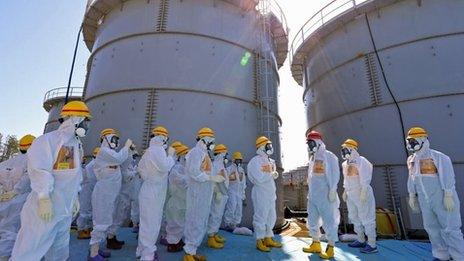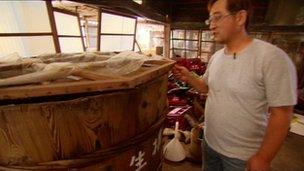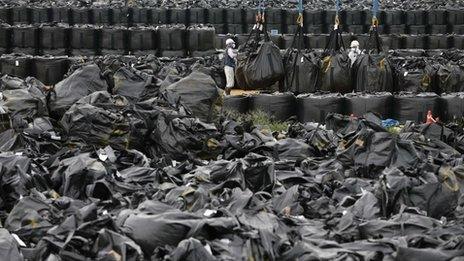What have we learned from Fukushima?
- Published
Wingfield-Hayes Fukushima
Since moving to Japan in 2012, I have reported on the aftermath of the Fukushima nuclear disaster - speaking to experts, visiting the site and watching the clean-up. For the Editors, a programme which sets out to ask challenging questions, I consider what I have learned.
Firstly, Fukushima was not an unavoidable natural disaster. For many outside Japan it is easy to draw the conclusion that Fukushima is unique, as very few places experience such huge earthquakes and tsunamis as Japan. So, the logic goes, there are no real lessons to be learned for other countries.
Much the same was said after the Chernobyl nuclear disaster in Ukraine in 1986. Chernobyl was a bad design, a similar accident could not happen in Japan, which has Western-designed reactors. But it did.
Prof Kiyoshi Kurokawa chaired the Japanese parliamentary inquiry in to the Fukushima disaster and his conclusions are devastating. It was, he told me: "Man-made, and made in Japan."
Tatsujiro Suzuki, the deputy head of Japan's Atomic Energy Commission, has also been damning.
"There were studies which showed a one-in-1,000-year probability of the Fukushima coast being hit by a 10m tsunami," he said. "Unfortunately, those studies were dismissed. The nuclear industry didn't think it would happen, so they didn't prepare for it," he said.
For me, this is the most revealing and shocking part of the Fukushima story. When the earthquake and tsunami hit on 11 March 2011 there was no plan for how to deal with such a large and complex disaster. How was this allowed to happen?
Prof Kurokawa blames what he calls "regulatory capture", a process by which the nuclear power industry "captured" the bureaucracy that was supposed to regulate it.
Put crudely, the "poachers" and the "gamekeepers" were far too close. Many senior bureaucrats from Japan's Nuclear Industry Safety Agency would take lucrative jobs in the nuclear industry after leaving government.
The result was a nuclear industry imbued with a culture of arrogance, secrecy and complacency. Lessons learned after Chernobyl and Three Mile Island in the US were not implemented here. When disaster struck, Japan was woefully ill-prepared.

The Fukushima nuclear plant has suffered a number of water leaks
'Too trusting'
An investigation by Japan's NHK broadcaster last year found that simple equipment, things like mobile generators and battery packs that could have helped prevent the meltdowns, were sitting at a depot just 25 miles (40km) from the Fukushima plant.
After the tsunami knocked out the plant's electrical system there was still time to bring in the back-up equipment. Army helicopters were on standby. But there was no plan. Chaos ensued.
A senior company official in charge of logistics was asked by the NHK team why he had not dispatched the equipment. "We had a very long list of things they needed. We had no way to prioritise which should go first," he said.

Hirohisa Suzuki is one of the 26,000 nuclear refugees evacuated from Namie
And so the back-up equipment stayed in the depot, and the reactor cores melted down.
Nor was there any evacuation plan. In the little town of Namie, five miles (8km) north of the plant, Hirohisa Suzuki was clearing up debris from the quake when the order came to leave.
"People were just told to head north west," he told me, "but that was exactly the same direction the radiation cloud was moving. Some people were evacuated to an area where the radiation was even higher than here."
In retrospect, Mr Suzuki agrees the whole town was far too trusting. They were told the plant was safe, so no-one had ever asked whether there was a disaster plan.
Two and a half years later, Mr Suzuki and the 26,000 people who lived in Namie are still nuclear refugees as radiation in parts of the town is still too high for residents to return. His family's 150-year-old miso and soy sauce business may never reopen.
This is the other thing I have learned: cleaning up a nuclear disaster is extremely difficult. That may sound obvious, but just how complex only becomes apparent when you see how it is done.
Out of bounds
In the large town of Minamisoma, 19 miles (30km) north of the plant, they are cleaning virtually every house. I watch a team of men using high-power sprayers to clean the roof of a farmhouse, surrounded by plastic sheets to catch the waste water, which is then pumped into a nearby tanker.
Another team of men is removing topsoil from the garden and putting it in huge plastic bags. The garden is then covered in a 2in (5cm) layer of fresh sand. Behind the house, shrubs and bamboo are being cut down and bagged. It will take a team of 20 men two days to finish this one house.

Huge dumps are being created to contain the waste from the radiation clean-up
But much of Fukushima prefecture is covered in densely-forested mountains. How do you clean forest? The answer is you cannot. So large areas may have to be declared out of bounds for decades.
Finally, there is the waste. Already the clean-up is generating huge quantities. I was taken to a "temporary" dump deep in the mountains near the little town of Kawauchi. This single dump contains 50,000 cubic metres of waste. Kawauchi alone already has four dumps this size, and it is building a fifth.
Just how temporary these dumps really are is another question Japan's government is unable to answer. The radiation in the dumps will gradually fall. In 30 years it will be half the level it is today. But the Caesium 137 and Strontium 90 will not be gone completely for 300 years.
Finally let me end by quoting again Tatsujiro Suzuki, the deputy head of Japan's Atomic Energy Commission. I asked him why, if the nuclear industry knows there is a possibility of a disaster, does it continue to tell the public nuclear power is safe?
"We need to be prepared for the worst case. We need to tell the public this is the worst case. But if we tell the worst case, the public says ,'Don't build the reactor near here.' So that was the dilemma. And if you want to continue building nuclear power plants you have to keep telling people the reactors should be safe. But now that myth is gone."
BBC News: The Editors features the BBC's on-air specialists asking questions which reveal deeper truths about their areas of expertise. It was first broadcast on BBC One on Monday 30 September. Watch it again on iPlayer or on BBC World News.
- Published4 September 2013
- Published21 July 2011
- Published4 September 2013